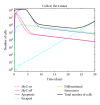In vivo imaging-based mathematical modeling techniques that enhance the understanding of oncogene addiction in relation to tumor growth
- PMID: 23573174
- PMCID: PMC3616361
- DOI: 10.1155/2013/802512
In vivo imaging-based mathematical modeling techniques that enhance the understanding of oncogene addiction in relation to tumor growth
Abstract
The dependence on the overexpression of a single oncogene constitutes an exploitable weakness for molecular targeted therapy. These drugs can produce dramatic tumor regression by targeting the driving oncogene, but relapse often follows. Understanding the complex interactions of the tumor's multifaceted response to oncogene inactivation is key to tumor regression. It has become clear that a collection of cellular responses lead to regression and that immune-mediated steps are vital to preventing relapse. Our integrative mathematical model includes a variety of cellular response mechanisms of tumors to oncogene inactivation. It allows for correct predictions of the time course of events following oncogene inactivation and their impact on tumor burden. A number of aspects of our mathematical model have proven to be necessary for recapitulating our experimental results. These include a number of heterogeneous tumor cell states since cells following different cellular programs have vastly different fates. Stochastic transitions between these states are necessary to capture the effect of escape from oncogene addiction (i.e., resistance). Finally, delay differential equations were used to accurately model the tumor growth kinetics that we have observed. We use this to model oncogene addiction in MYC-induced lymphoma, osteosarcoma, and hepatocellular carcinoma.
Figures







Similar articles
-
Tumor dormancy, oncogene addiction, cellular senescence, and self-renewal programs.Adv Exp Med Biol. 2013;734:91-107. doi: 10.1007/978-1-4614-1445-2_6. Adv Exp Med Biol. 2013. PMID: 23143977 Free PMC article.
-
Survival and death signals can predict tumor response to therapy after oncogene inactivation.Sci Transl Med. 2011 Oct 5;3(103):103ra99. doi: 10.1126/scitranslmed.3002018. Sci Transl Med. 2011. PMID: 21974937 Free PMC article.
-
A mathematical model of tumor regression and recurrence after therapeutic oncogene inactivation.Sci Rep. 2021 Jan 14;11(1):1341. doi: 10.1038/s41598-020-78947-2. Sci Rep. 2021. PMID: 33446671 Free PMC article.
-
Oncogene addiction versus oncogene amnesia: perhaps more than just a bad habit?Cancer Res. 2008 May 1;68(9):3081-6; discussion 3086. doi: 10.1158/0008-5472.CAN-07-5832. Cancer Res. 2008. PMID: 18451131 Review.
-
Noncanonical roles of the immune system in eliciting oncogene addiction.Curr Opin Immunol. 2013 Apr;25(2):246-58. doi: 10.1016/j.coi.2013.02.003. Epub 2013 Apr 6. Curr Opin Immunol. 2013. PMID: 23571026 Free PMC article. Review.
References
-
- Weinstein IB, Begemann M, Zhou P, et al. Disorders in cell circuitry associated with multistage carcinogenesis: exploitable targets for cancer prevention and therapy. Clinical Cancer Research. 1997;3(12):2696–2702. - PubMed
-
- Demetri GD. Identification and treatment of chemoresistant inoperable or metastatic GIST: experience with the selective tyrosine kinase inhibitor imatinib mesylate (STI571) European Journal of Cancer. 2002;38:S52, supplement–S59. - PubMed
-
- Druker BJ, Talpaz M, Resta DJ, et al. Efficacy and safety of a specific inhibitor of the BCR-ABL tyrosine kinase in chronic myeloid leukemia. New England Journal of Medicine. 2001;344(14):1031–1037. - PubMed
-
- Kantarjian H, Sawyers C, Hochhaus A, et al. Hematologic and cytogenetic responses to imatinib mesylate in chronic myelogenous leukemia. New England Journal of Medicine. 2002;346(9):645–652. - PubMed
-
- Weisberg E, Manley PW, Breitenstein W, et al. Characterization of AMN107, a selective inhibitor of native and mutant Bcr-Abl. Cancer Cell. 2005;7:129–141. - PubMed
Publication types
MeSH terms
Substances
Grants and funding
LinkOut - more resources
Full Text Sources
Other Literature Sources
Medical

